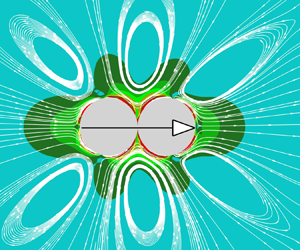Crossref Citations
This article has been cited by the following publications. This list is generated based on data provided by
Crossref.
Joens, Mary Agnes
Doyle, Patrick S.
and
McKinley, Gareth H.
2024.
The motion of a self-propelling two-sphere swimmer in a weakly viscoelastic fluid.
Journal of Non-Newtonian Fluid Mechanics,
Vol. 334,
Issue. ,
p.
105330.
Ying, Yuxiang
Jiang, Tongxiao
Li, Siwen
Nie, Deming
and
Lin, Jianzhong
2024.
Study of sedimentation characteristics of an elliptical squirmer in a vertical channel.
Physica Scripta,
Vol. 99,
Issue. 2,
p.
025304.
Lin, Zhaowu
Zhang, Minkang
Chen, Xingfan
Cheng, Xiaoliang
and
Yu, Zhaosheng
2024.
Hydrodynamic interactions between two microswimmers in viscoelastic fluids.
Physics of Fluids,
Vol. 36,
Issue. 8,
Ying, Yuxiang
Guan, Geng
and
Lin, Jianzhong
2024.
Hydrodynamic behavior of inertial elongated microswimmers in a horizontal channel.
International Journal of Non-Linear Mechanics,
Vol. 166,
Issue. ,
p.
104838.
Ouyang, Zhenyu
Liu, Chen
Lin, Zhaowu
and
Lin, Jianzhong
2024.
Modeling a spheroidal squirmer through a complex fluid.
Physical Review Fluids,
Vol. 9,
Issue. 7,
Zhang, Minkang
Yu, Zhaosheng
Ouyang, Zhenyu
Xia, Yan
and
Lin, Zhaowu
2024.
Numerical study of collective motion of microswimmers in Giesekus viscoelastic fluids.
Journal of Non-Newtonian Fluid Mechanics,
Vol. 329,
Issue. ,
p.
105245.
Zhang, Minkang
Yu, Zhaosheng
Xia, Yan
Ouyang, Zhenyu
Chen, Sheng
and
Lin, Zhaowu
2024.
Collective motions of microorganisms in geometric confinement.
Physics of Fluids,
Vol. 36,
Issue. 12,
Quan, Yufeng
Yu, Zhaosheng
Lin, Jianzhong
Ouyang, Zhenyu
Xia, Yan
and
Lin, Zhaowu
2025.
Microorganisms swimming in Giesekus viscoelastic fluids at finite Reynolds numbers.
Physics of Fluids,
Vol. 37,
Issue. 8,
Lin, Zhaowu
Li, Rujiang
Xia, Yan
Ouyang, Zhenyu
Yu, Zhaosheng
and
Lu, Wei
2025.
Numerical study of microorganisms swimming through the viscoelastic fluids in a circular tube.
Physics of Fluids,
Vol. 37,
Issue. 9,
Xia, Yan
Yu, Zhaosheng
Lin, Jianzhong
Lin, Zhaowu
and
Hu, Xiao
2025.
Dynamics of a spheroidal squirmer interacting with a cylindrical obstacle.
Soft Matter,
Vol. 21,
Issue. 17,
p.
3267.
Xia, Yan
Yu, Zhaosheng
Lin, Zhaowu
and
Ishikawa, Takuji
2025.
Swimming and mixing of an ellipsoidal squirmer in a viscoplastic fluid.
Journal of Fluid Mechanics,
Vol. 1015,
Issue. ,
Cai, Xinwei
Wang, Kuiliang
Li, Gaojin
and
Bian, Xin
2025.
Simulating squirmers with smoothed particle dynamics.
Physical Review E,
Vol. 111,
Issue. 4,
Xia, Yan
Yu, Zhaosheng
Zhang, Minkang
Lin, Zhaowu
and
Ouyang, Zhenyu
2025.
Swimming dynamics of a spheroidal microswimmer near a wall.
Physical Review E,
Vol. 111,
Issue. 4,
Ouyang, Zhenyu
Li, Gaojin
Lin, Zhaowu
Lin, Jianzhong
and
Yu, Zhaosheng
2025.
Transport characteristics of finite-size microorganisms in turbulent channel flows.
Journal of Fluid Mechanics,
Vol. 1007,
Issue. ,
Zhu, Chenlin
Peng, Fangyuan
Pan, Dingyi
Yu, Zhaosheng
and
Lin, Zhaowu
2025.
Numerical study of microorganisms swimming near a convex wall in a Giesekus fluid.
Physical Review E,
Vol. 111,
Issue. 1,
Chaithanya, K.V.S.
and
Thampi, Sumesh P.
2025.
Viscoelastic effects on the hydrodynamics of an active compound particle.
European Journal of Mechanics - B/Fluids,
Vol. 114,
Issue. ,
p.
204324.
Zhang, Minkang
Yu, Zhaosheng
Xia, Yan
Zhu, Chenlin
Lin, Zhaowu
and
Lu, Wei
2025.
The collective motion of a binary pusher-puller mixture in viscoelastic fluids.
Engineering Applications of Computational Fluid Mechanics,
Vol. 19,
Issue. 1,
Quan, Yufeng
Zhang, Minkang
Yu, Zhaosheng
Lin, Jianzhong
Xia, Yan
and
Lin, Zhaowu
2025.
The locomotion of microorganisms in viscoelastic fluids at finite Reynolds numbers.
Journal of Fluid Mechanics,
Vol. 1020,
Issue. ,



